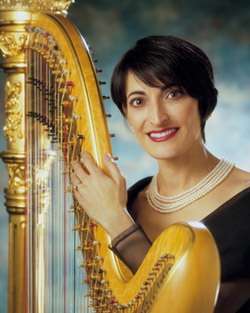|
Back
Mozart, Debussy, Ravel, and Brahms in the Afternoon Cincinnati
First Unitarian Church
03/27/2011 - & March 28, 2011
Wolfgang Amadeus Mozart: Flute Quartet No. 1 in C Major, K. 285b
Claude Debussy: Sonata for Flute, Viola and Harp
Maurice Ravel: Introduction and Allegro for Flute, Harp, Clarinet, and Strings
Johannes Brahms: Piano Quintet in F Minor op. 34
Stewart Goodyear (piano), Randolph Bowman (flute), Richie Hawley (clarinet), Gillian Benet Sella (harp), Timothy Lees (violin), Gabriel Pegis (violin), Michael Strauss (viola), Ilya Finkelshteyn (cello) 
G. Benet Sella (Courtesy of Linton Chamber Music Series)
TheFlute Quartet No. 1 in C Major is the best known of four chamber pieces for flute and strings that Mozart composed for the instrument that he, inexplicably, hated the most. The B minor Adagio is an enchanting study in brevity, with the flute pouring out a melody redolent of Gluck's Dance of the Blessed Spirits. Flautist Randolph Bowman's exquisite musicality, supported by the filigree work of his colleagues Timothy Lees, Michael Strauss, and Ilya Finkelshteyn, on violin, viola and cello, opened the sunny early Spring afternoon's concert with elegant playing.
Debussy hated being called “impressionistic”, yet his Sonata for flute, viola, and harp is a marvel of “Impressionistic” tone painting, much like a musical Renoir canvas. Harpist Gillian Benet Sella, flautist Randolph Bowman and violist Michael Strauss did gorgeous work in this quintessentially-French piece, notably in the episodic, tonally -ambiguous opening Pastorale - an ecstatic movement where the viola plays long held notes while the harp pierces the bucolic atmosphere with massive clusters of sound. Written by the composer during the First World War and premiering one year before his death in 1918, it ranges in style and tone from neo-classical to bracingly modern. The players navigated the sudden shifts in mood with aplomb and utmost clarity.
Maurice Ravel's Introduction and Allegro for flute, harp, clarinet, and string quartet is one of those showpieces for which harpists live and die. Running just under ten minutes of intense playing, this is a carefree work written well before the between-the-lines ironies of the Piano Concerto for the Left Hand and La Valse. A sensual and dreamy work, the piece is really a mini-concerto for harp, often-heard in an orchestral arrangement. No lush orchestration was needed here, as the work was brilliantly played by the dazzlingly virtuosic harpist Gillian Benet Sella and the razor-sharp ensemble of Randolph Bowman on flute, Richie Hawley on clarinet, Timothy Lees and Gabriel Pegis on violins, Michael Strauss on viola, and Ilya Finkelshteyn on cello.
Divided into four movements, Johannes Brahms' Piano Quintet in F Minor is a feast of Brahmsian inventiveness, daring in its harmonies, unusual in structure, exciting in its dramatic transitions from major to minor keys, and stirring in its finale's Hungarian chromaticism. With its overall musical depiction of joy, elation, fury, struggle, pride and ultimate triumph, this is a muscular, heroic work that calls for major players. Eloquent, technically beyond reproach and full of Romantic bravura, pianist Stewart Goodyear – in town for an appearance with the Cincinnati Symphony Orchestra (read here), scored a triumph, accompanied by the fiery playing of violinists Timothy Lees, and Gabriel Pegis, violist Michael Strauss and cellist Ilya Finkelshteyn.
Enormous gratitude is due to the Linton Chamber Music Series at the First Unitarian Church.
Bravi tutti!
The Linton Chamber Music Series
Rafael de Acha
|